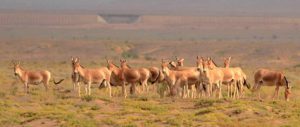A group of wealthy Chinese entrepreneurs have started an experiment in private nature conservation, shaking up China’s traditional, government-led approach to protecting landscapes and wildlife.
Late last year, 16 of the best known figures from China’s business world applied to the provincial government of Sichuan, western China, for permission to establish the “Sichuan Nature Protection Fund”. Their names will be familiar to anyone with a passing knowledge of Chinese industry: Jack Ma, chairman of the Alibaba Group, Ou Yaping, founder of Sinolink Worldwide Holdings, Huang Nubo, chairman of Beijing Zhongkun Investment Group, and Hu Zuliu, of Chunhua Capital are all involved. So too are Guo Guangchan, co-founder of Shanghai Fosun High Technology, Niu Gensheng, founder of the Lao Niu Foundation, and Zheng Yonggang, chairman of Shanshan Investment Holdings.
There are plans to invite other big names: Tencent founder Ma Huateng, NetEase chief executive Ding Lei and Broad Air Conditioning founder Zhang Yue, among others.
A list like this makes it one of China’s richest philanthropic groupings. To become an executive director of the board, you need to make “an initial donation of at least 3 million yuan [US$457,000]”. After the project is formally launched, “a voluntary donation of at least 5 million yuan [US$762,000]” will be required.
In China, running nature reserves has always been government business. The country has 2,538 protected areas, 70% of them managed by the forestry authorities. The rest fall under the jurisdiction of, variously, the departments for environmental protection, agriculture, land and resources, rural development and oceans. These entrepreneurs aim to shake up the status quo, with a “privately founded, privately managed and privately operated” reserve, in which the government plays only a regulatory role.
If all goes to plan, a 50-million yuan (US$7.6 million) start-up fund will be spent on conservation around Xuebao Peak and Motian Ridge in Pingwu county, north-east Sichuan. Xuebao Peak is believed to be one of the 25 most biodiverse locations in the world, while the Motian Ridge is home to 30 protected species, including the giant panda, golden monkey and the Takin antelope.
The project has been pulled together by US-based NGO The Nature Conservancy (TNC). Yang Peng, chair of the expert committee at Chinese foundation Alishan Society of Entrepreneurs and Ecology describes TNC as “both scientists and capitalists”. “They’ve got an incredible ability to raise money worldwide and they work very much like an investment bank. They bring in huge amounts of money.”
In early 2010, Jack Ma became the first Chinese member of TNC’s global board. Among the founders of the new fund for Sichuan, Niu Gensheng, Ou Yaping, Huang Nubo and Hu Zuliu have also recently become trustees of TNC’s China programme.
Yang Peng describes this as a kind of “elite entrepreneurial culture”. Increasingly in China, business figures are not satisfied with simply making donations – they want to do actual philanthropic work.
The Sichuan project will bring together the wealth of these entrepreneurs with the environmental expertise of TNC – one side providing the cash, the other the know-how. As well as putting up money, the fund will establish a largely independent management body which will employ personnel and set budgets for implementing an ecological-monitoring system, conservation measures and community engagement. For example, a team of environmental experts led by Wang Dajun of Peking University will carry out a 10 to 20-year survey of black bear and panda populations in the area.
The strength of the Sichuan project lies in its access to something that all of China’s nature reserves are struggling for: money.
In the United States, nature reserves get 70% of their funding from government, 10% from the public and 20% from commercial operations. But in China, just 40% of funding comes from government and 5% from the public, with the remaining 55% generated by commercial operations. It’s easy to see that a lack of funds is forcing China’s nature reserves to pursue profit-making activities.
For a while in the 1990s, local governments rushed to establish new nature reserves, but there was limited investment. At the same time, regulations governing protected areas put clear limits on what production and development could take place within them. In 2005, the State Environmental Protection Agency (now the Ministry of Environmental Protection) reported on nine cases where the rules had been broken, mostly involving mining or road-building. Nature reserves were often seen as an impediment to commercial development.
Lu Zhi is head of Chinese NGO, the Shan Shui Conservation Center. She says “it is common for reserves founded after the year 2000 to be under-funded and under-staffed – especially in the west of China.”
Whoever is doing the protecting, they cannot avoid issues of development and vested interests. If local people’s right to economic progress is not ensured, they will look to exploit the reserve and protection will be impossible. Former head of the International Union for Conservation of Nature and member of its World Commission on Protected Areas Wang Xianpu says that “many reserves now are at one extreme or the other – either over-protected, or over-developed.”
Chinese civil-society organiser Lu Chao says environmental philanthropy rarely leads to quick results – outside of China, just 3% of philanthropic donations go to the environment. However, Lu believes wealthy Chinese individuals are more focused on the environment than elsewhere and that the country, as a result, may fare better.
Nonetheless, public concerns are hard to put to rest. Song Linfei, director of Jiangsu’s Academy of Social Sciences says: “China’s scenic areas are suffering unprecedented destruction, all in the name of tourism.”
Take the Changbaishan National Nature Reserve, which is aiming to become a “world-class tourist attraction” as an example. Of 49 scenic areas identified here, many are deep in protected zones or buffer areas, where tourism is supposed to be forbidden. There are plans for 11 five-star hotels, 15 to 20 hot spring resort villages, five ski resorts and three golf clubs. According to the UN’s Man and the Biosphere Programme, populations of almost all wild animals within the resort dropped sharply between 2006 and 2008.
But the figures behind the Sichuan project are confident they can prevent excessive development at the same time as providing local livelihoods. As part of their plans, they hope to assist local-government efforts in both attracting development and establishing a regulatory system to oversee that development.
Plans being drawn up include ideas such as “having hunters act as wardens, and helping locals find markets for honey”.
The project will undoubtedly face fierce lobbying from those pushing for unconstrained economic development, including influential figures in business and government. It will be tough to see this off – but perhaps these rich and powerful philanthropists have a better chance of succeeding than most.
This article was first published by Southern Weekend, where Xu Nan is a reporter.
Homepage image from the State Forestry Administration of China


